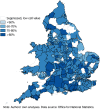Gender differences and individual, household, and workplace characteristics: Regional geographies of extended working lives
- PMID: 33664632
- PMCID: PMC7893678
- DOI: 10.1002/psp.2213
Gender differences and individual, household, and workplace characteristics: Regional geographies of extended working lives
Abstract
Increasing labour market participation among older workers is embedded in government policy in the United Kingdom and many other industrialised countries with rises in the state pension age in response to increasing life expectancy. Despite this, many workers stop working before state pension age with around a 20% reduction in the proportion of adults in work between ages 50 and 60 in 2011 in England and Wales. This paper considers the risk of remaining in work by region and gender between 2001 and 2011 for adults aged 40-49 in 2001. Men had significantly higher risk of extended working in the East Midlands (1.4×) East of England (1.5×), South East (1.6×), and South West (1.6×) compared with the North East. Women in all regions apart from London and Wales had significantly higher risk of extended working compared with the North East: ranging from 1.15 times in the North West and West Midlands to 1.6 times in the South West. Adjustment for nonemployment-related socio-economic status, housing tenure, qualifications, and car ownership, and employment status in 2001 attenuated all significant regional differences in extended working in men and in women in most regions. Workplace characteristics attenuated most of the remaining regional differences in women: women working in larger employers in 2001 or working at distances of 200 km or more, abroad or from home, had lower risk of remaining in work, whereas access to a car and higher working hours increased risk. Policies to increase qualifications and skills among older adults are recommended.
Keywords: later life work; longitudinal study; retirement; unemployment; work exit.
© 2018 The Authors Population, Space and Place Published by John Wiley & Sons Ltd.
Figures
Similar articles
-
Population-based estimates of healthy working life expectancy in England at age 50 years: analysis of data from the English Longitudinal Study of Ageing.Lancet Public Health. 2020 Jul;5(7):e395-e403. doi: 10.1016/S2468-2667(20)30114-6. Lancet Public Health. 2020. PMID: 32619541
-
Barriers and facilitators to extended working lives in Europe: a gender focus.Public Health Rev. 2017 Jan 31;38:2. doi: 10.1186/s40985-017-0053-8. eCollection 2017. Public Health Rev. 2017. PMID: 29450074 Free PMC article. Review.
-
Demographic, health, physical activity, and workplace factors are associated with lower healthy working life expectancy and life expectancy at age 50.Sci Rep. 2024 Mar 11;14(1):5936. doi: 10.1038/s41598-024-53095-z. Sci Rep. 2024. PMID: 38467680 Free PMC article.
-
Geographical variation and migration analysis of height, weight and body mass index in a British cohort study.J Biosoc Sci. 2011 Nov;43(6):733-49. doi: 10.1017/S0021932011000381. Epub 2011 Jul 28. J Biosoc Sci. 2011. PMID: 21794200
-
Health and inclusive labour force participation.Lancet. 2023 Oct 14;402(10410):1382-1392. doi: 10.1016/S0140-6736(23)00868-1. Lancet. 2023. PMID: 37838443 Review.
Cited by
-
Is working in later life good for your health? A systematic review of health outcomes resulting from extended working lives.BMC Public Health. 2021 Jul 9;21(1):1356. doi: 10.1186/s12889-021-11423-2. BMC Public Health. 2021. PMID: 34238265 Free PMC article.
References
-
- Arber, S. , & Ginn, J. (1995). Connecting gender and ageing: A sociological approach. Buckingham: Open University Press.
-
- CeLSIUS . (2013). Social class www.ucl.ac.uk/celsius/online‐training/socio/se040100 (accessed 24/2/2017)
-
- Chandler, D. and Tetlow, G . (2014). Employment and retirement—Explaining recent trends IFS http://www.ifs.org.uk/publications/7413 (accessed 24/2/2017)
-
- Crawford, R. , & Tetlow, G. (2010). Employment, retirement and pensions In Banks J., Lessof C., Nazroo J., Rogers N., Stafford M., & Steptoe A. (Eds.), Financial circumstances, health and well‐being of the older population in England. London: IFS.
-
- Cridland, J . (2017). Independent review of the State Pension Age. Smoothing the transition. Final report https://assets.publishing.service.gov.uk/government/uploads/system/uploa... (accessed 25/07/2018)
LinkOut - more resources
Full Text Sources



